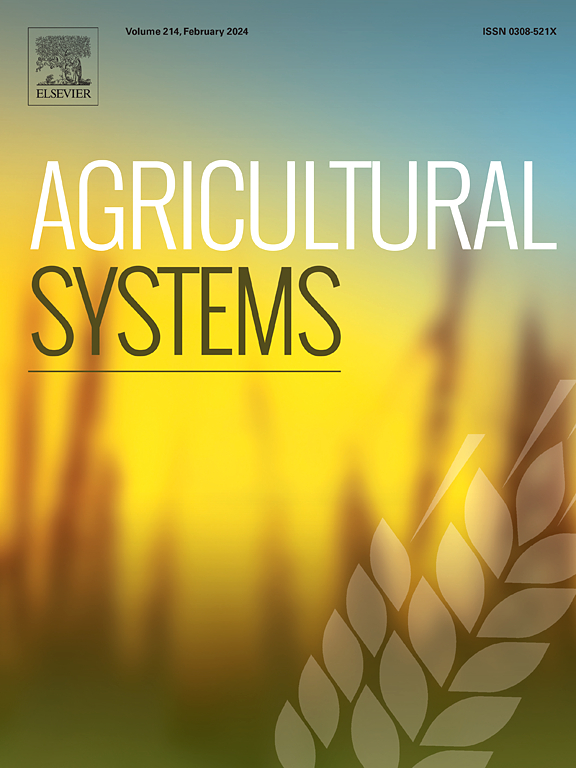Decision support for managing an invasive pathogen through efficient clean seed systems: Cassava mosaic disease in Southeast Asia
IF 6.1
1区 农林科学
Q1 AGRICULTURE, MULTIDISCIPLINARY
引用次数: 0
Abstract
Context
Effective seed systems must distribute high-performing varieties efficiently, and slow or stop the spread of pathogens and pests. Epidemics increasingly threaten crops around the world, endangering the livelihoods of smallholder farmers. Responding to these challenges to food and economic security requires stakeholders to act quickly and decisively during the early stages of pathogen invasions, typically with limited resources. A current threat is the introduction of cassava mosaic virus in Southeast Asia.
Objectives
Our goal in this study is to provide a decision-support framework for efficient management of healthy seed systems, applied to cassava mosaic disease. The specific objectives are to (1) evaluate disease risk in disease-free parts of Cambodia, Lao PDR, Thailand, and Vietnam; (2) incorporate estimated risk of disease establishment with seed exchange survey data and whitefly spread in the landscape to model epidemic spread; and (3) identify candidate regions to be prioritized in seed system management.
Methods
We used machine learning to integrate disease occurrence, climate, topology, and land use, and network meta-population models of epidemic spread. We used scenario analyses to identify candidate priority regions for management.
Results and conclusions
The analyses allow stakeholders to evaluate strategic options for allocating their resources in the field, guiding the implementation of seed system programs and responses. Consistently targeting initially high priority locations with clean seed produced more favorable outcomes in this model, as did prioritization of a higher number of districts for the deployment of smaller volumes of clean seed.
Significance
The decision-support framework presented here can be applied widely to seed systems challenged by the dual goals of distributing seed efficiently and reducing disease risk. Data-driven approaches support evidence-based identification of optimized surveillance and mitigation areas in an iterative fashion, providing guidance early in an epidemic, and revising recommendations as data accrue over time.

通过高效清洁的种子系统管理入侵病原体的决策支持:东南亚木薯花叶病
有效的种子系统必须有效地分配高性能品种,并减缓或阻止病原体和害虫的传播。流行病日益威胁世界各地的作物,危及小农的生计。应对粮食和经济安全面临的这些挑战,需要利益攸关方在病原体入侵的早期阶段迅速果断地采取行动,通常资源有限。目前的威胁是木薯花叶病毒在东南亚的传入。目的为木薯花叶病种子系统的有效管理提供决策支持框架。具体目标是:(1)评估柬埔寨、老挝人民民主共和国、泰国和越南无病地区的疾病风险;(2)结合种子交换调查数据和白蝇在景观中的传播情况,估算疾病建立的风险,建立流行病传播模型;(3)确定种子系统管理的优先候选区域。方法利用机器学习技术,整合疾病发生、气候、拓扑、土地利用等因素,建立流行病传播的网络元人口模型。我们使用场景分析来确定管理的候选优先区域。结果和结论这些分析使利益相关者能够评估在实地分配资源的战略选择,指导种子系统计划的实施和应对措施。在该模型中,始终如一地将清洁种子定位于最初高度优先的地区会产生更有利的结果,同样,将更多的地区优先考虑,以部署较小数量的清洁种子。意义本文提出的决策支持框架可广泛应用于种子系统高效分配和降低病害风险的双重目标。数据驱动的方法支持以迭代的方式以证据为基础确定优化的监测和缓解领域,在流行病早期提供指导,并随着时间的推移随着数据的积累修订建议。
本文章由计算机程序翻译,如有差异,请以英文原文为准。
求助全文
约1分钟内获得全文
求助全文
来源期刊

Agricultural Systems
农林科学-农业综合
CiteScore
13.30
自引率
7.60%
发文量
174
审稿时长
30 days
期刊介绍:
Agricultural Systems is an international journal that deals with interactions - among the components of agricultural systems, among hierarchical levels of agricultural systems, between agricultural and other land use systems, and between agricultural systems and their natural, social and economic environments.
The scope includes the development and application of systems analysis methodologies in the following areas:
Systems approaches in the sustainable intensification of agriculture; pathways for sustainable intensification; crop-livestock integration; farm-level resource allocation; quantification of benefits and trade-offs at farm to landscape levels; integrative, participatory and dynamic modelling approaches for qualitative and quantitative assessments of agricultural systems and decision making;
The interactions between agricultural and non-agricultural landscapes; the multiple services of agricultural systems; food security and the environment;
Global change and adaptation science; transformational adaptations as driven by changes in climate, policy, values and attitudes influencing the design of farming systems;
Development and application of farming systems design tools and methods for impact, scenario and case study analysis; managing the complexities of dynamic agricultural systems; innovation systems and multi stakeholder arrangements that support or promote change and (or) inform policy decisions.
 求助内容:
求助内容: 应助结果提醒方式:
应助结果提醒方式:


